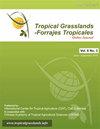冲绳产热带草青贮相关乳酸菌的鉴定与特性研究
IF 0.7
4区 农林科学
Q3 AGRICULTURE, DAIRY & ANIMAL SCIENCE
引用次数: 1
摘要
在冲绳县,2011-2016年农业总产量的增长率是日本最高的,小牛的销售量在日本全国排名第四。饲喂优质青贮饲料养牛在营养和经济上都是有益的。然而,人们对冲绳热带草青贮饲料中乳酸菌(LAB)的存在知之甚少。为了提高对青贮发酵过程的认识,对一系列青贮(Digitaria eriantha, Megathyrsus maximus, Chloris gayana, Urochloa mutica, Sorghum sp.和Zea mays)中存在的LAB进行了鉴定。所有分离菌均为革兰氏阳性,以过氧化氢酶阴性菌为主。根据形态和生化特征,将37株分离菌株分为16个类群,经16S rDNA序列分析,鉴定为植物乳杆菌7株、副植物乳杆菌3株、短乳杆菌1株、酸化乳杆菌1株、干酪乳杆菌3株、发酵乳杆菌1株、副肠乳杆菌9株、泡菜乳杆菌1株、乳酸乳球菌亚种5株。2种为garvieae乳球菌,4种为戊糖童球菌。冲绳青贮中一些种类繁多的乳酸菌可能有利于提高青贮质量,并计划进一步研究以确定在青贮时接种特定菌种的饲料的效益。本文章由计算机程序翻译,如有差异,请以英文原文为准。
Identification and characterization of lactic acid bacteria associated with tropical grass silage produced in Okinawa
In Okinawa, rate of increase in gross agricultural production during 2011‒2016 was the highest in Japan and sales of calves ranked fourth throughout Japan. Raising cattle by feeding high quality silage is beneficial both nutritionally and economically. However, little is known about lactic acid bacteria (LAB) present in silages made from tropical grass in Okinawa. To improve understanding of fermentation processes in silages, the LAB present in a range of silages (Digitaria eriantha, Megathyrsus maximus, Chloris gayana, Urochloa mutica, Sorghum sp. and Zea mays) were identified. All isolates were Gram-positive and mainly catalase-negative bacteria. According to morphological and biochemical characters, 37 isolates were divided into 16 groups and on the basis of 16S rDNA sequence analysis, 7 were identified as Lactobacillus plantarum, 3 as L. paraplantarum, 1 as L. brevis, 1 as L. acidipiscis, 3 as L. casei, 1 as L. fermentum, 9 as Weissella paramesenteroides, 1 as W. kimchii, 5 as Lactococcus lactis subsp. lactis, 2 as Lactococcus garvieae and 4 as Pediococcus pentosaceus. Some of this wide variety of LAB in Okinawan silage could be beneficial for improving quality of silages and further studies are planned to determine benefits of inoculating forage with particular strains at ensiling.
求助全文
通过发布文献求助,成功后即可免费获取论文全文。
去求助
来源期刊

Tropical Grasslands-Forrajes Tropicales
Agricultural and Biological Sciences-Agronomy and Crop Science
CiteScore
1.60
自引率
0.00%
发文量
36
审稿时长
16 weeks
期刊介绍:
The Journal publishes, in English or Spanish, Research Papers and Short Communications on research and development, as well as contributions from practitioners (Farmer Contributions) and Review Articles, related to pastures and forages in the tropics and subtropics. There is no regional focus; the information published should be of interest to a wide readership, encomprising researchers, academics, students, technicians, development workers and farmers.
In general, the focus of the Journal is more on sown (''improved'') pastures and forages than on rangeland-specific aspects of natural grasslands, but exceptions are possible (e.g. when a submission is relevant for a particularly broad readership in the pasture and forage science community).
The Journal will also consider the occasional publication of associated, but closely related, research in the form of an additional scientific communication platform [e.g. a re-make of the former Genetic Resources Communication series of the former Division of Tropical Crops and Pastures of the Commonwealth Scientific and Industrial Research Organisation (CSIRO), Australia].
Areas of particular interest to the Journal are:
Forage Genetic Resources and Livestock Production[...]
Environmental Functions of Forages[...]
Socio-economic Aspects[...]
Topics within the aforementioned areas may include: Diversity evaluation; Agronomy; Establishment (including fertilization); Management and utilization; Animal production; Nutritive value; Biotic stresses (pests and diseases, weeds); Abiotic stresses (soil fertility, water, temperature); Genetics and breeding; Biogeography and germplasm collections; Seed production; Ecology; Physiology; Rhizobiology (including BNF, BNI, mycorrhizae); Forage conservation; Economics; Multilocational experimentation; Modelling.
 求助内容:
求助内容: 应助结果提醒方式:
应助结果提醒方式:


